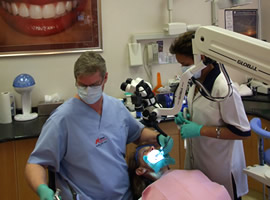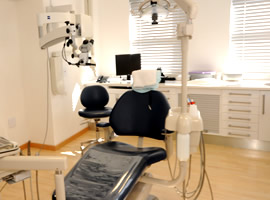Tooth Replacement
Guide to Implants in Dentistry.........Getting Back Your Own Teeth !
Do you avoid laughing aloud, smiling and eating in public because your denture may slip or because an unsightly space left by missing teeth may show ?
If so, dental implants may improve the way you feel about your teeth. No matter how many teeth you are missing, dental implants may make it possible for you to eat and speak with comfort and confidence again. Your natural teeth are stable biting and chewing surfaces because they are supported by your jawbone. This ia also true of dental implant – supported teeth because successful dental implants become firmly embedded in the jaw, providing a strong and stable anchor for chewing surfaces as secure as those of natural teeth.
Although there may be many options to replace lost teeth, currently the best available choice is with dental implants. A dental implant is an artificial root that is placed in the jaw and can be used as an anchor for a replacement tooth. This stabilizes the bite and helps preserve the surrounding bone.
Losing teeth, particularly back teeth, has important long-term implications. The more obvious consequences are the associated loss of chewing function and bite support, and the fewer remaining teeth are forced to do a job that more teeth were intended to do. Less obvious consequences are the movement of the adjacent and opposing teeth around the spaces created when teeth are lost. However, probably the most destructive consequence is the extensive bone loss that occurs in the jaw after a tooth has been removed.
Why have Dental Implants become so popular ?
As our lifespan increases, the need for some type of permanent dental replacement system becomes very important to our overall health. Dentures and removable bridges have obvious problems. They are loose and unstable. Implants can provide people with dental replacements that are both functional and aesthetic. The demand was always there – we just needed the tools to predictably fulfill that demand.
What are Implants ?
In the simplest terms, an implant is a man-made artificial tooth root. The implant itself is made from a titanium alloy and is implanted in the jawbone to function like the root of your missing tooth. Dental implants can replace missing teeth and provide an alternative to full dentures, partial dentures and fixed bridge work.
What are the advantages of Implants ?
The advantages vary from patient to patient and the type of replacement that the patient opts for. In the case of full or partial dentures, implants allow for increased chewing ability and better speech. Implants have helped many patients with:-
- regaining their self-confidence by knowing that their dentures are fixed in place. A fixed denture helps to eliminate the gag reflex sometimes associated with dentures.
- assisting in making food more enjoyable and tasting better.
- far less irritation (sore spots) to the delicate tissues of the mouth.
In short, implants allow patients to replace their teeth with artificial teeth that are closer to their natural teeth than anything else available.
When replacing a single tooth, an implant has an advantage over fixed bridgework in that healthy teeth adjacent to the missing tooth do not have to be prepared. An artificial tooth can be placed in the space without touching or damaging the other teeth in the area.
Are you a candidate for Implants ?
Whether you are a candidate for Implants can only be determined after a complete and thorough examination.
Important factors that need to be considered are the general health of the patient and the quantity and quality of the bone in the jaw at the potential site of placement. Implants have a very high success rate, failing in less than 5% of cases. The rate of success is significantly reduced in smokers. However, after stopping smoking, the risk of failure reduces to that of the non-smoking population.
How are Implants done ?
Implants are usually placed under local anaesthesia in the implant surgeon’s office. After placement the implant is allowed to heal, during which bone surrounds and attaches the surface of the implant in a process called osseointegration. This process takes approximately 3 to 6 months, depending on the quality of the bone at the site and whether in the upper or lower jaw. After the healing interval the top of the implant is exposed and can then be utilized for restoration of replacement teeth. The restoration can be attached using clips in the case of dentures, or screwed or cemented in the case of crowns or bridgework. The number and type of implants and the exact method of implantation and restoration varies from case to case.
Implant Process
The Implant process is most commonly a three-step procedure. The first two steps involve minor surgery. The third step involves making and attaching the new teeth.
- During your first surgery, the implants are placed.
- During your second surgery, the implants are uncovered or exposed.
- During the last step, your new tooth is attached.
Immediate Tooth Replacement
In some circumstances teeth can be removed, an implant placed immediately and a temporary tooth filled - all in the same visit. This helps to minimise the number of surgical procedures, as well as avoiding the inconvenience of not having to wait before a tooth can be replaced.
Bridges
In some situations, particularly where the teeth on either side of a gap are already crowned or are extensively filled, the most appropriate choice to replace lost teeth may be with a conventional bridge. The teeth on either side of the space are prepared for crowns that support a framework spanning the gap and replacing the lost tooth. When replacing front teeth modern high-tech all ceramic materials can be used in bridges which are strong and durable and are very natural and attractive in appearance.
A FINAL WORD
Implants offer a tremendous advantage to replacing missing teeth on some patients. If you have any questions about implants please ask us. Your smile is our business. Our goal is to help preserve your smile..................for a lifetime !!!!!! |



